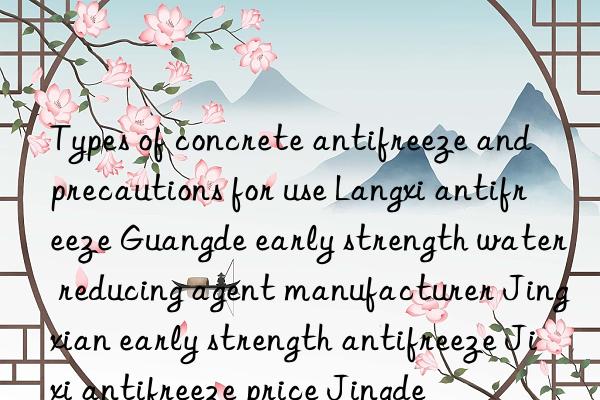
During winter construction, the water in the newly poured concrete is easy to freeze, increasing its volume by 9% and seriously damaging the internal structure of the concrete. Therefore, we must take some anti-freeze measures during construction. measure. Among the many antifreeze methods, adding concrete antifreeze to concrete is a method often used in construction.
Since the 1970s, my country's concrete antifreeze has developed rapidly, and there are many brands of antifreeze. Improper selection will have a negative impact on the quality of concrete. When choosing antifreeze, be sure to choose the appropriate type of antifreeze based on concrete with or without reinforcement. Today's antifreeze types can be roughly divided into three categories: chlorine salts, chlorine salt rust inhibitors, and chlorine-free salts:
1. Chlorine salts
p>Chloride salt antifreeze is mainly composed of sodium chloride and calcium chloride and other early strength components, water-reducing components, air-entraining components, etc. Made of admixtures. It has good water reduction, early strength and freezing point lowering effects, but it has a rust-promoting effect on steel bars. It will cause the volume to expand to twice its original size, causing cracks in the concrete, forming a vicious cycle, and even causing damage to concrete buildings. Therefore, chloride antifreeze is only suitable for unreinforced concrete projects.
2. Chlorine salt rust inhibitor
This type of antifreeze is mainly based on chlorine salt and rust inhibitor. The rust agent is mainly an admixture compounded with water-reducing components, early strength components, air-entraining components, etc. It has the effects of water reduction, early strength, antifreeze and rust prevention, and can be widely used in reinforced concrete projects.
3. Chlorine-free salts
This type of antifreeze is based on nitrite and nitrate , carbonate and urea as the main compound additives. It has no rusting effect on steel bars, but nitrites and nitrates can cause stress corrosion. Therefore, it cannot be used in prestressed concrete projects and reinforced concrete structures in galvanized steel or in contact with aluminum and iron. Antifreeze produced from urea is rarely used now because large amounts of it pollute the environment. Antifreeze produced by regular manufacturers is often compound antifreeze. It can fully bring together the advantages of various components, which can reduce water, strengthen, lower the freezing point, accelerate the hydration of cement under negative temperature conditions, improve early strength, and reduce the damage to concrete caused by freezing stress, so this kind of antifreeze It has good antifreeze effect and is an ideal antifreeze agent in winter concrete construction.
If you choose the correct antifreeze and use it improperly, it will also affect the quality of the concrete. Therefore, you should pay attention to the following points when using concrete antifreeze:
Ask the manufacturer to provide product manuals, product identification reports from designated government departments and the manufacturer's product certificate to prevent the purchase of substandard products.
Be sure to use the dosage provided by the manufacturer within the specified temperature or use the cement at the construction site to determine the dosage through testing, and send a dedicated person to control the dosage.
During construction, the adaptive temperature of the admixture must be controlled according to the lowest daily temperature, so that it is safe to use.
When using liquid antifreeze, if there is precipitation, stir it evenly before use. If powder antifreeze becomes wet and clumps, it should be ground through a 0.63mm sieve before use.
Reactive aggregates or aggregates mixed with activated silica shall not be used in concrete construction. Because antifreeze contains a lot of potassium and sodium ions, it will react with active silicon oxide during the hardening process of concrete to cause concrete expansion, leading to structural damage and reducing the usability and durability of concrete.
In winter construction, if the construction requirements are met, less water must be used and the water-cement ratio must be strictly controlled as required.
When the temperature is lower than -5°C, hot water can be used to mix concrete. When the water temperature is higher than 65°C, the hot water should be mixed with the aggregate first and then added During cement mixing, when the temperature is low and -10℃, the aggregates can be moved to a greenhouse or heating measures can be taken.
The exit temperature of the concrete mixture mixed with antifreeze shall not be lower than 10°C, and the mold entry temperature shall not be lower than 5°C.
Concrete mixed with antifreeze must not be poured on a frozen foundation. If the foundation freezes, insulation measures should be taken.
Before pouring concrete, the ice, snow and dirt on the formwork and steel bars should be removed, but steam should not be used to directly melt the ice and snow to avoid freezing again.
Concrete mixed with antifreeze should be poured within 15 minutes when it is transported to the pouring site, and after the pouring is completed, the exposed concrete surface should be covered with plastic film or insulation material.
Concrete mixed with antifreeze must not be watered and cured under negative temperature conditions. The initial maintenance temperature must not be lower than the specified temperature of the antifreeze, otherwise heat preservation measures should be taken.
When the difference between the surface temperature of the concrete and the ambient temperature after the formwork is removed is greater than 15°C, it should be covered and cured with insulation materials.
In short, in winter concrete construction, in addition to selecting suitable antifreeze and strictly following product instructions and specifications during construction, there are also specific requirements during construction. We rely on us to observe more, compare more, analyze and summarize more when problems arise, and combine a variety of predictions.Only by taking special construction measures can we effectively prevent the concrete structure from freezing.



 微信扫一扫打赏
微信扫一扫打赏
